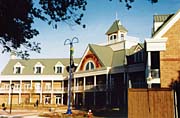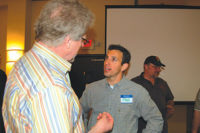
People, animals and the environment are pretty important constituents. Consideration of this principled mission certainly was a factor for developers when the zoo expanded, building a new Education/Entry Complex and Visitor Center. The city of Norfolk and the Virginia Zoological Society adopted a master growth plan in 1992 that would culminate in the completion of this magnificent new complex. Fundraising actually began back in 1993, drawing from a supporter base from all across the Norfolk area. The master plan included a zoological/geographical vision of Africa, North America, Australia, South America and Asia, rising beyond the new entry center. The recent $5 million expansion consisted of a picturesque entry plaza, fountain and courtyard, as well as a new building housing visitor services, educational space, zoo administration offices and a gift shop.
The educational complex and visitor center, of course, had to fit in with the zoo’s environmentally conscious mission statement. That concern for creating a “green” building naturally led the zoo’s developers to use environmentally friendly roofing products. The architectural firm chosen for the project was Torre Design Consortium LTD. of New Orleans, which has participated in more than 30 zoological construction products around the country. Senior Associate Jeff Borchardt was among those responsible for choosing to use environmentally friendly products. He has personally participated in renowned zoo projects including the Audubon Park & Zoological Garden in New Orleans; the Lowry Park Zoo and Busch Gardens in Tampa; the Woodland Park Zoo in Seattle; the Dallas Zoo, Wilds of Africa; and the famous Brookfield Zoo in Chicago.
“It’s becoming very important to consider environmental impact when specifying products for zoo projects,” Borchardt says. For example, in regard to roofing insulation, “You just don’t want wildlife exposed to harmful gases at a facility whose purpose is to be respectful of nature.” And yet performance is still important, “When we chose a roof insulation product, we were basically looking to maximize the R-Value performance while minimizing thickness.”
Borchardt chose ACFoam Nail base from Atlas Roofing Corp., Atlanta. The company has a history and reputation for being environmentally responsible. In 1998, years ahead of the Environmental Protection Agency’s timetable for eliminating HCFCs (hydrochlorofluorocarbons), Atlas introduced the ACFoam line, which does not deplete the stratospheric ozone layer or contribute to the effects of global warming. The company’s roof insulation product offerings are available for virtually every type of construction system, so it just made good sense to use the product in a zoological park.
The roofing contractor on the job was Baker Roofing Co., a Virginia company with locations in Norfolk and Roanoke. The company, which was founded in 1980, has extensive experience in all types of roofing construction, including developments as large as 1.5 million square feet of roof coverage. Baker Roofing Company is a member of the National Roofing Contractors Association, the Virginia Association of Roofing Contractors and the Associated Builders and Contractors. The stunning roof system for this project is a Hemlock Green Englert 24-gauge galvanized steel standing seam. Almost two hundred boards of ACFoam Nail Base Insulation were used, resulting in a roof that is truly “green” inside and out.
The general contractor on the Virginia zoo project was CBC of Norfolk, Va. Project Manager Michael Helman says his company is “always happy to accommodate subcontractors who can provide environmentally friendly products for the projects we get involved in. It is more important, even imperative, when the products are in close proximity to wildlife such as on this project. When we drove piles on this job, the elephants went crazy. It was like we were invading their territory. I guess we really were. That was a first for me!”
A key area of the new educational complex and visitor center is the classroom space for after-school enrichment and School Discovery Programs. It is in these classrooms, contained in a “green” building, that students and others learn about the importance of preserving and conserving the earth’s animals and environment. Most North American zoos are proud members of the American Zoo and Aquarium Association. This environmentally driven group says it pretty well in the “vision” portion of their mission statement, “with passion, leadership and collective action, we celebrate and conserve the wonders of the natural world.”

Report Abusive Comment